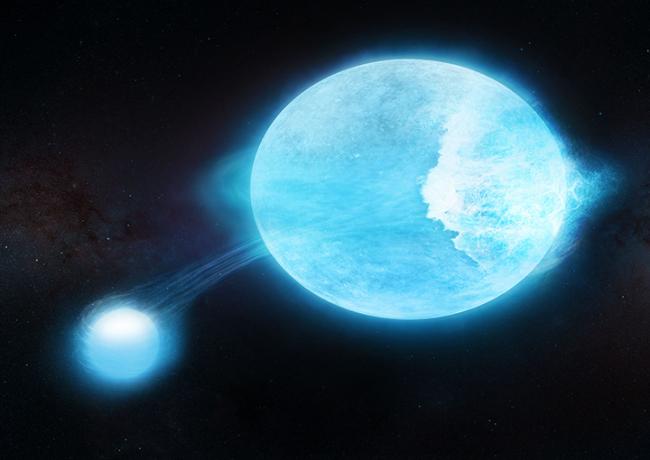An unusual star system that brightens and fades every month might have giant plasma waves breaking on its surface.

Melissa Weiss (Center for Astrophysics, Harvard & Smithsonian)
They’re much too hot and too tenuous to ride a surfboard on, but astronomers believe there are humongous breaking waves on the sloshing surface of a massive star.
According to Morgan MacLeod and Abraham Loeb (both at Center for Astrophysics, Harvard & Smithsonian), these waves reach heights of more than 4 million kilometers (2.5 million miles), before crashing back on the blue giant star, releasing incredible amounts of energy in the process. “Amazing to imagine what’s happening on the surface of the star,” says Edward Guinan (Villanova University), who was not involved in the study.
The giant star is 24 times as large and 35 times as massive as our Sun and is located in the Large Magellanic Cloud, a companion galaxy to our Milky Way at some 167,000 light-years away. First identified as variable by the Massive Compact Halo Objects (MACHO) collaboration back in 2001, the giant is now known as MACHO 80.7443.1718. The 13th-magnitude star brightens and dims again by 0.4 magnitude every 32.8 days.
In 2019, a team led by Tharindu Jayasinghe (Ohio State University) reported convincing evidence that MACHO 80.7443.1718 is a so-called heartbeat star — an unusual type of binary first identified by NASA’s Kepler space telescope. Due to the highly elliptical orbits of these systems, the two stars experience huge tidal deformations that cause their brightness to vary as they approach and recede from each other.
However, according to a group of Polish astronomers led by Piotr Kołaczek-Szymański (University of Wrocław), MACHO 80.7443.1718 is an extreme example. Its brightness variations are much larger than in regular heartbeat stars; it rotates unusually fast (once every 4.4 days), which should give the star a highly oblate shape; and the orbital period is slowly decaying by 11 seconds per year.
To better understand this strange system, MacLeod and Loeb carried out detailed 3D hydrodynamical computer simulations of the binary, with surprising results. During closest approach, the companion star raises huge tidal waves on the diluted surface of the blue giant — three times as high as the diameter of our Sun — that subsequently break like ocean waves on a beach. As MacLeod writes in a blog post, “the smooth motion of each wave crashes back into itself and devolves into the disordered motion of turbulence, much like the foamy mess that forms as Earth’s ocean waters crash back into the shore.”
Morgan MacLeod (Center for Astrophysics, Harvard & Smithsonian)
When the waves crash down on the bigger star’s surface, they accelerate its rotation, explaining its fast spin rate. Moreover, part of the “foamy mess” ends up in an extended, tenuous atmosphere, which shows up in the star’s spectrum as bright emission lines, indicating that the crashing waves dissipate about 100 times more energy than the Sun radiates — an energy loss that neatly matches that of the observed orbital decay. “Connecting these features demonstrates that MACHO 80.7443.1718 is a natural product of massive binary star evolution”, the authors write August 10th in Nature Astronomy.
“This is an intriguing study of a fascinating interacting high mass binary system,” says Guinan. However, he notes that the conclusions are mostly inferred from theory and hydrodynamic calculations and simulations. “There is really no ‘hard’ observational evidence for the proposed huge clashing waves,” he cautions. “More observations are needed to be sure.”
These may not only come from further studies of this particular binary. According to MacLeod and Loeb, MACHO 80.7443.1718 is likely just the first of a growing class of objects. This class captures what MacLeod calls a “brief and transformative moment in a long stellar lifetime.”
Indeed, the companion star is bound to be consumed by the more massive giant, explains Guinan, either as a result of the orbital shrinkage, or because the blue giant further evolves into a much larger red giant – whichever comes first. That will definitely mark the end of the stellar surf season.
 1
1









Comments
mjmorri
August 18, 2023 at 10:33 am
Surf's up. Who's going to try first.
You must be logged in to post a comment.
You must be logged in to post a comment.